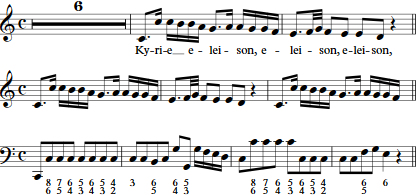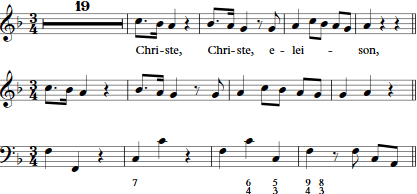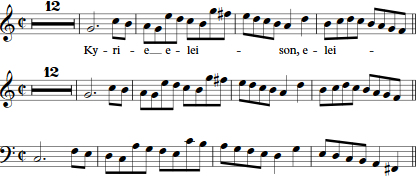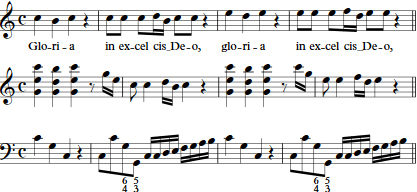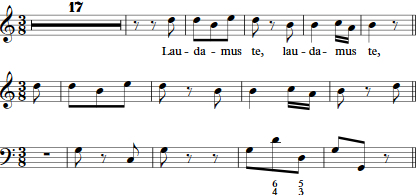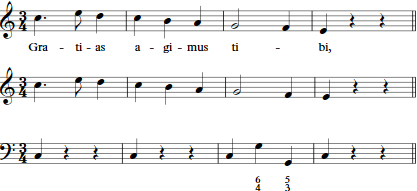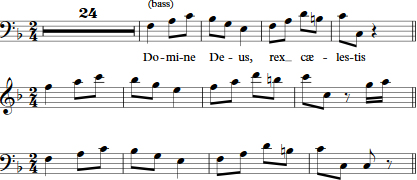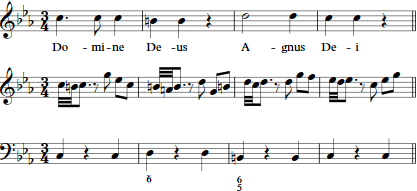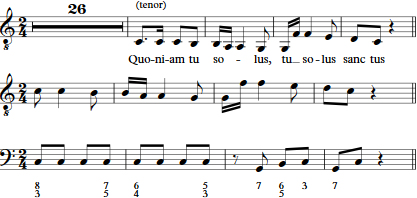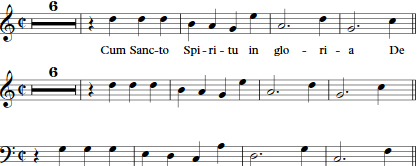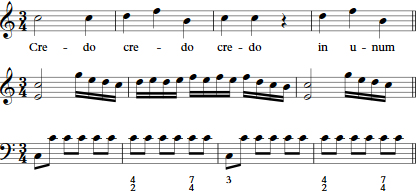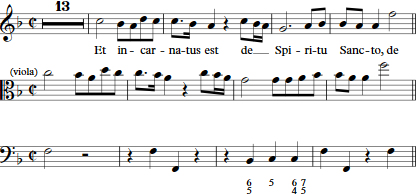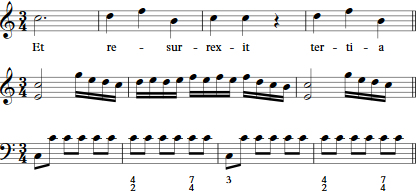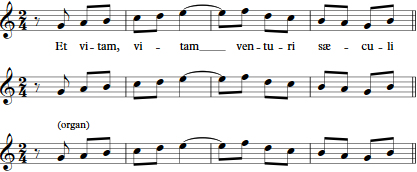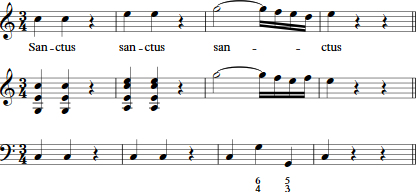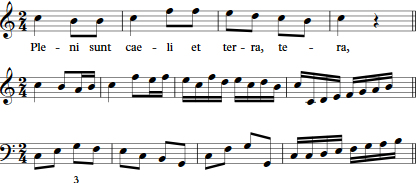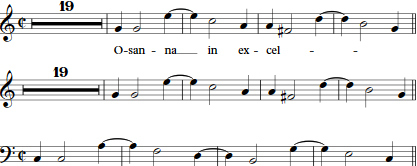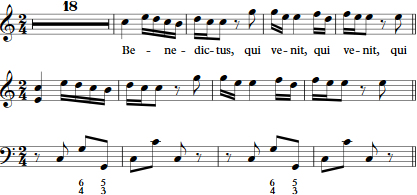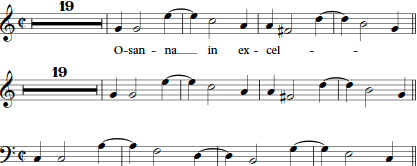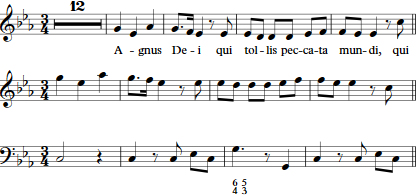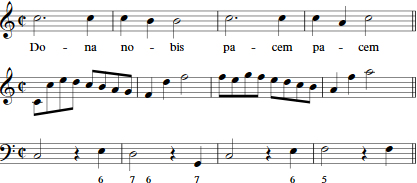Johann Baptist Wanhal
Missa in C Nokki 12 [Weinmann XIX:C4]
Wanhal ?
Nokki 12
Weinmann XIX:C4
Authenticity: probably authentic
This work exist in a number of versions, with no known counterattributions. It exhibits several strategies typical of Wanhal, and fits well along with his other the 'Domine Deus' masses.
Versions
In addition to the original version, an arrangement of the Kyrie and Gloria for two choirs and two orchestras (!) were made by Jan Jakob Trautzl in the Cistercian monastery Osek in 1785. The remaining movements were taken from a mass by Anton Zimmermann (AZ VIII/1: C4; Mudra2011).
In the performance parts, however, the organ part contains the remaining movements of Wanhal's mass. This part is transposed down two half steps. As wind instruments made for church often had a concert pitch that could be as much as two half steps higher than instruments intended for secular use, and the transposed organ part might suggest that wind instruments had to be borrowed from elsewhere. This is supported by Osek1753, which contains a list of the instruments in the monastery of 1755 and an addendum from 1802. These suggest that the monastery only were in the possession of two oboes at the time, and would have had to borrow two from elsewhere. Whilst it is listed as having owned six trumpets in 1755 (this is not mentioned in the 1802 addendum), it is not obvious that four of these would have been able to perform together in C, especially if oboes had to be procured elsewhere. All things considered, it seems likely that the transposed organ part is evidence of such borrowing, and most likely from a secular owner.
The existence of a transposed organ part for the movement suggests that there were also performances where the Kyrie and Gloria would have been performed polychorally, before the ensembles performed the remaining movements together. As performance dates only survive on the short score of Zimmermann's movements, there is little reason to believe that these performances are recorded here.
Missa Integra
In the Osek version, this mass is given the title 'Missa Integra', or 'complete mass'. This is to separate it from the many Kyrie/Gloria masses found in the repertoire here, and possibly to separate the original from the aforementioned arrangement by Trautzl.
| 1779 | Copy in Rajhrad dated |
| 1780 | Copy from the Augustinian monastery in Brno dated |
| 1783 | Copy in Osek dated |
| 20 August 1785 | Performance of the Trautzel arrangement in the honour of Saint Bernard of Clairvaux |
| 31 August 1785 | Performance of the Trautzel arrangement in the honour of Saint Raymond Nonnatus |
| 1851 | Replacement title page on the copy from Rahjrad monastery dated |
Original version
 Music
Music
Kyrie
 Sections
Sections
Gloria
 Sections
Sections
-
4. Gloria
Tempo: Allegro moderato
Metre: 𝄴
Key: C major
Extent: 99 bars
-
5. Laudamus te
Tempo: Andante
Metre: 3
8
Key: G major
Extent: 130 bars
-
6. Gratias
Tempo: Allegro moderato
Metre: 3
4
Key: C major
Extent: 121 bars
One also finds the tempo Allegro molto used, sometimes within different voices in the same manuscript. The choice of Allegro moderato as the suggested tempo is built on an admittedly flimsy foundation: (1) it is more often found in Wanhal's works, and (2) Jan Jakup Trautzel used it in his version, which was derived from a manuscript where both versions were found.
-
7. Domine Deus
Tempo: Andante
Metre: 2
4
Key: F major
Extent: 150 bars
-
8. Domine Deus Agnus Dei
Tempo: Adagio
Metre: 3
4
Key: C minor
Extent: 91 bars
-
9. Quoniam
Tempo: Allegro moderato
Metre: 2
4
Key: C major
Extent: 333 (!) bars
-
10. Cum Sancto Spiritu
Tempo: Allegro
Metre: 𝄵
Key: C major
Extent: 100 bars
Credo
 Sections
Sections
Sanctus
 Sections
Sections
-
15. Sanctus
Tempo: Adagio
Metre: 3
4
Key: C major
Extent: 15 bars
Both Andante and Andante molto are occasionally found as suggested tempi, with variations even between voices in the same manuscript.
-
16. Pleni sunt coeli
Tempo: Allegro
Metre: 2
4
Key: C major
Extent: 29 bars
-
17. Osanna I
Tempo: Allegro
Metre: 𝄵
Key: C major
Extent: 43 bars
-
18. Benedictus
Tempo: Andante
Metre: 2
4
Key: C major
Extent: 109 bars
-
19. Osanna II
Tempo: Allegro
Metre: 𝄵
Key: C major
Extent: 43 bars
Da capo of Osanna I.
Agnus Dei
 Sources
Sources
Performance parts, Museum of Music, Prague
Musical director: Jan Jakob Trautzl.
Originally from the Cistercian monastery Osek. This copy was almost certainly the original the variants Nokki 12b and Nokki 12c were made from, and is therefore likely to have been made no later than 1785. Whilst Osek1751 claims that this work has two horn parts, this is almost certainly an oversight, rather than evidence of a lost copy.
The name 'Missa Integra' (complete mass) might refer to one of two things. In Czechia it was common to perform large-scale Kyrie-Gloria masses, and works that also contained the remaining movements were occasionally named Missa Integra. It might also be that this is a reference to the local arrangement of the work as a polychoral Kyrie-Gloria mass. If the latter is true, this use must already have been conceived of when the title page was made.
Performance parts, Moravian Museum, Brno
Scribe: Maurus Haberhauer.
From the Benedictine monastery Rahjrad.
Performance parts, Minorite convent, Prague
Scribe: Methudius Kreibich.
Not seen. Information taken from RISM. 14 parts: S, A, T, B, vl. I, vl. II., vla. I, vla. II, vlc., ob. I, ob. II, clno. I, clno. II, timp., org.
This manuscript only contains Credo-Agnus Dei. The opening of the Credo has been retexted (beginning with "Patrem omnipotentem"), probably to allow the priest to intone the first words.
Performance parts, Stams Monastery
Owner: Stefan Paluselli.
Not seen. Information taken from RISM.
Performance parts, Ottobeuren, Benedictine abbey
Not seen. Information taken from RISM.
-
Kyrie and Gloria
Title page: Kyrie et Gloria. C | à | Canto, Alto | Tenore, Basso | Violinis 2bus | Obois 2bus | Violis 2bus | Clarinis 2bus in C | Tympanis | Con | Organo. | Del Sig. Wanhall.D-OB MO 877.RISM 450008358. -
Credo and Agnus Dei
Title page: Credo et Agnus. C | à | Canto, Alto | Tenore, Basso | Violinis 2bus | Obois 2bus | Violis 2bus | Clarinis 2bus | Tympanis | Con | Organo. | Del Sig. Wanhall.D-OB MO 876.RISM 450008357.
Performance parts, Waigolshausen, Catholic church
Former owner: Georg Wirsching.
Not seen. Infromation from RISM. 16 parts: S, A, T, B, vl. I, vl. II, vla. I, vla. II, ob. I, ob. II, cor. I, cor. II, clno. I, clno. II, timp., org. (Oboes switch to clarinettes in Et incarnatus."
The mass is erranously identified as C3 in RISM.
Copy, Augustinian monastery Brno
Not seen. Information taken from Weinmann 1987 (p. 198)
Copy, Bratislava, National Museum
Not seen. Information from Weinmann 1987 (p. 198).
Copy, Einsiedeln Monastery
Not seen. Information taken from Weinmann 1987 (II, 198, 213) and RISM. There are three folders in the Einsiedeln collection, which together comprise the entire mass except the Credo and Sanctus. Whether the extant manuscripts were originally intended as a full set is disputable: the smaller instrumentation and single copy of every voice suggests that this may have arisen separately, perhaps as a replacement for a lost set of parts. Weinmann, who probably was only familiar with the incipit from the Kyrie, failed to make the connection between the different component manuscripts.
Note that the number 1777 on the front of the Kyrie folder seems to have been interpreted as an archival number and not a dating. The Gloria is from 1795.
-
Kyrie
Title page: No: 1777. | Kyrie | à | 4. Voci | 2. Oboe | 2. Clarini in C. | 2 Corni in C. | 2. Violini | Viola | con | Organo, | Del Sige Vanhal.24 parts: S (x4), A (x3), T (x3), B (x2), vl 1 (x3), vl 2 (x3), vla, b, b.gif, ob 1, ob 2, cor 1, cor 2, clno 1, clno 2
CH-E 266,6 (Ms.3100).RISM 400013337. -
Gloria
Title page: Gloria | a quattro Voci | Del Sigre J. Wanhall12 parts: S, A, T, B, vl. I, vl. II, b., b. fig, cl. I, cl. II, clno. I, clno. II
Dated 1795 on the inside.CH-E 266,2 (Ms. 2098); 267,2 (Ms. 3098).RISM 400013343. -
Agnus Dei
Title page: Nro: 177. | Agnus Dei | à | 4 Voce | 2 Clarini in D. | Tympani. | 2 Oboe | 2. Corni in D. | 2 Violini | Viola | con | Organo, | Del Sige. Vanhal24 parts: S (x4), A (x3), T (x3), B (x2), vl 1 (x3), vl 2 (x3), vla, b, b.gif, ob 1, ob 2, cor 1, cor 2, clno 1, clno 2
CH-E 265,22 (Ms.3094).RISM 400013330.
Copy, Gniezno, Archbishopric Archive
Not seen. Information from Weinmann 1987 (p. 198).
Copy, Trencin
Not seen. Information taken from Weinmann 1987 (p. 198). Weinmann writes that the manuscript is to be found in "Trencin, Mus.-Slg.Jesuiten u.Piaristen, HSJP"
Arrangement of Kyrie and Gloria for two choirs and orchestras by Jan Jakup Trautzel
Nokki 12b
(All incipits are based on orchestra/choir 1 alone.)
 Music
Music
Kyrie
 Sections
Sections
Gloria
 Sections
Sections
-
4. Gloria
Tempo: Allegro moderato
Metre: 𝄴
Key: C major
Extent: 99 bars
-
5. Laudamus te
Tempo: Andante
Metre: 3
8
Key: G major
Extent: 130 bars
-
6. Gratias
Tempo: Allegro moderato
Metre: 3
4
Key: C major
Extent: 121 bars
One also finds the tempo Allegro molto used, sometimes within different voices in the same manuscript. The choice of Allegro moderato as the suggested tempo is built on an admittedly flimsy foundation: (1) it is more often found in Wanhal's works, and (2) Jan Jakup Trautzel used it in his version, which was derived from a manuscript where both versions were found.
-
7. Domine Deus
Tempo: Andante
Metre: 2
4
Key: F major
Extent: 150 bars
-
8. Domine Deus Agnus Dei
Tempo: Adagio
Metre: 3
4
Key: C minor
Extent: 91 bars
-
9. Quoniam
Tempo: Allegro moderato
Metre: 2
4
Key: C major
Extent: 333 bars
-
10. Cum Sancto Spiritu
Tempo: Allegro
Metre: 𝄵
Key: C major
Extent: 100 bars
Credo (Anton Zimmermann)
Sanctus (Anton Zimmermann)
Agnus Dei (Anton Zimmermann)
 Sources
Sources
Short score, Osek
Scribe: Jan Jakup Trautzel.
28 folia.
This is a short score laying out the sharing of material between the different choirs. Although it may conceivably have been used by a conductor, most likely it was intended as sketch for the performance material. This manuscript includes the Kyrie and Gloria alone. The Credo and Sanctus, written by Anton Zimmermann, is found in CZ-Pnm XXXII E 112. This source tells of a performance 'De anno 1785 p. Fest M:P:Bernardi', i.e. 20 August, and one for 'V:P:Reymondi', which might be a reference to the saint's day of Raymond Nonnatus, on 29 August.
Performance material, Osek
Scribe: Jan Jakup Trautzl.
Contains performance material taken from the short scores CZ-Pnm XXXIII B 8 (Kyrie-Gloria by Wanhal) and CZ-Pnm XXXII E 122 (Credo-Sanctus by Anton Zimmermann). The organ part, which is transposed down a whole step, contains the Credo-Agnus Dei from Wanhal's mass.
 Bibliography
Bibliography
Catalogus Musicalium pro Chori Ossecensi .... 1753-1894. CZ-Pnm č. př. 65/52 č. 3
Consignatio Musicalium ... pro Monasterio Rayhradensi. CZ-Bm 1771-?.
Haberkamp, Gertraut: Die Musikhandschriften der Benediktiner-Abtei Ottobeuren. G. Henle: Munich 1985.
Paluselli, Stefan: Registrum Musicalium Stamsensium. Sub auspiciis D. D. Sebastiani Abbatis. Opera Fr. Stephani Paluselli p. t. Chori-Directoris. 1791. Stams 1791.
Trautzl, Jan Jakup: Verzeichnis musicalische Werke vom Unterschriebene selbst gesetzt (= CZ-Pnm c.pr. 65/52 c. 11).
Weinmann, Alexander: Themen-Verzeichnis der Kompositionen von Johann Baptiste Wanhal. Musikverlag Ludwig Krenn: Vienna 1987.
File title:
Missa in C Nokki 12 [Weinmann XIX:C4]
File publication:
Editor: Halvor K. Hosar
Last changed 2020-11-21 by Halvor K Hosar
 Revision history
Revision history
| Date | Responsible | Description |
|---|---|---|
| 2020-11-21 | Halvor K Hosar |
